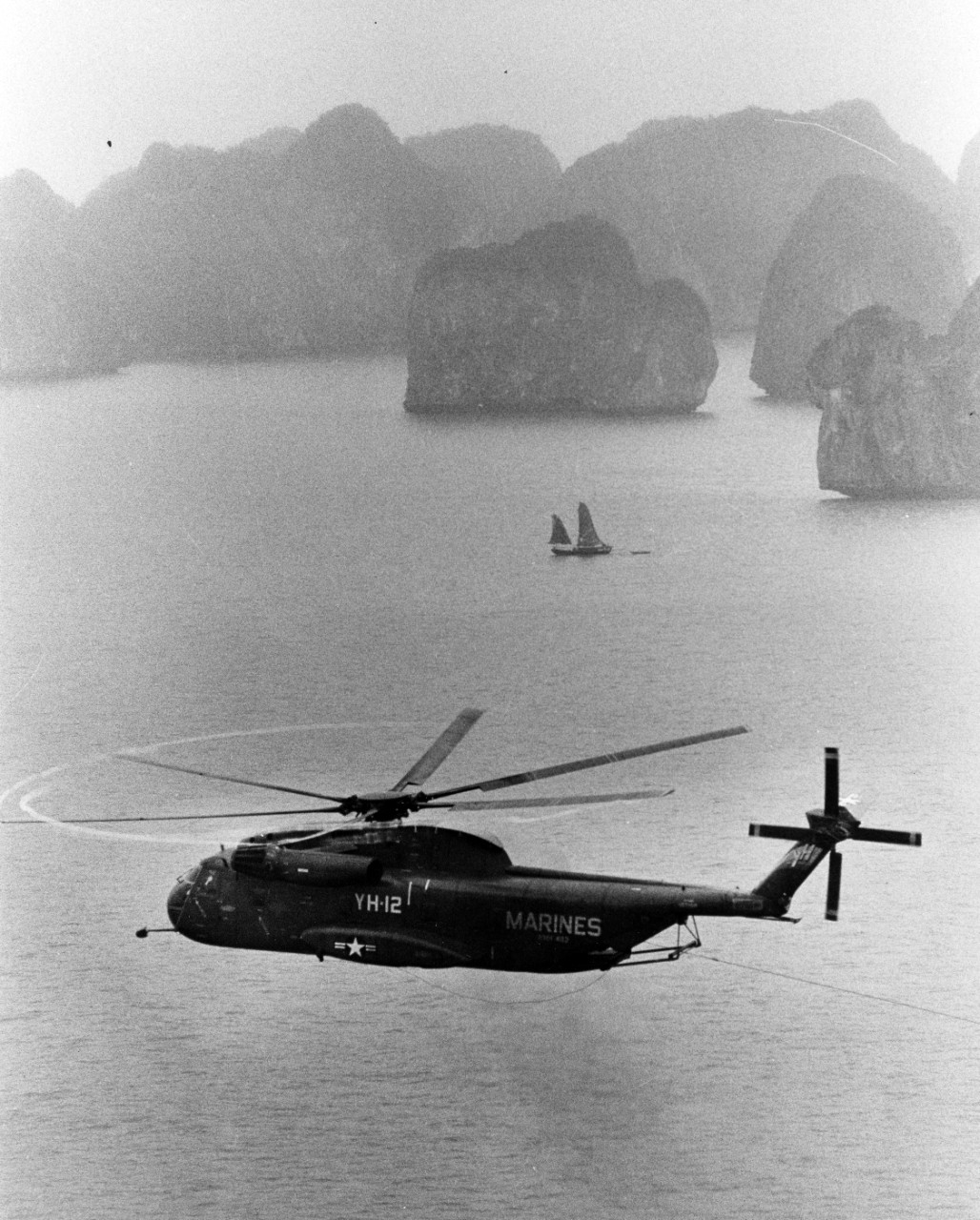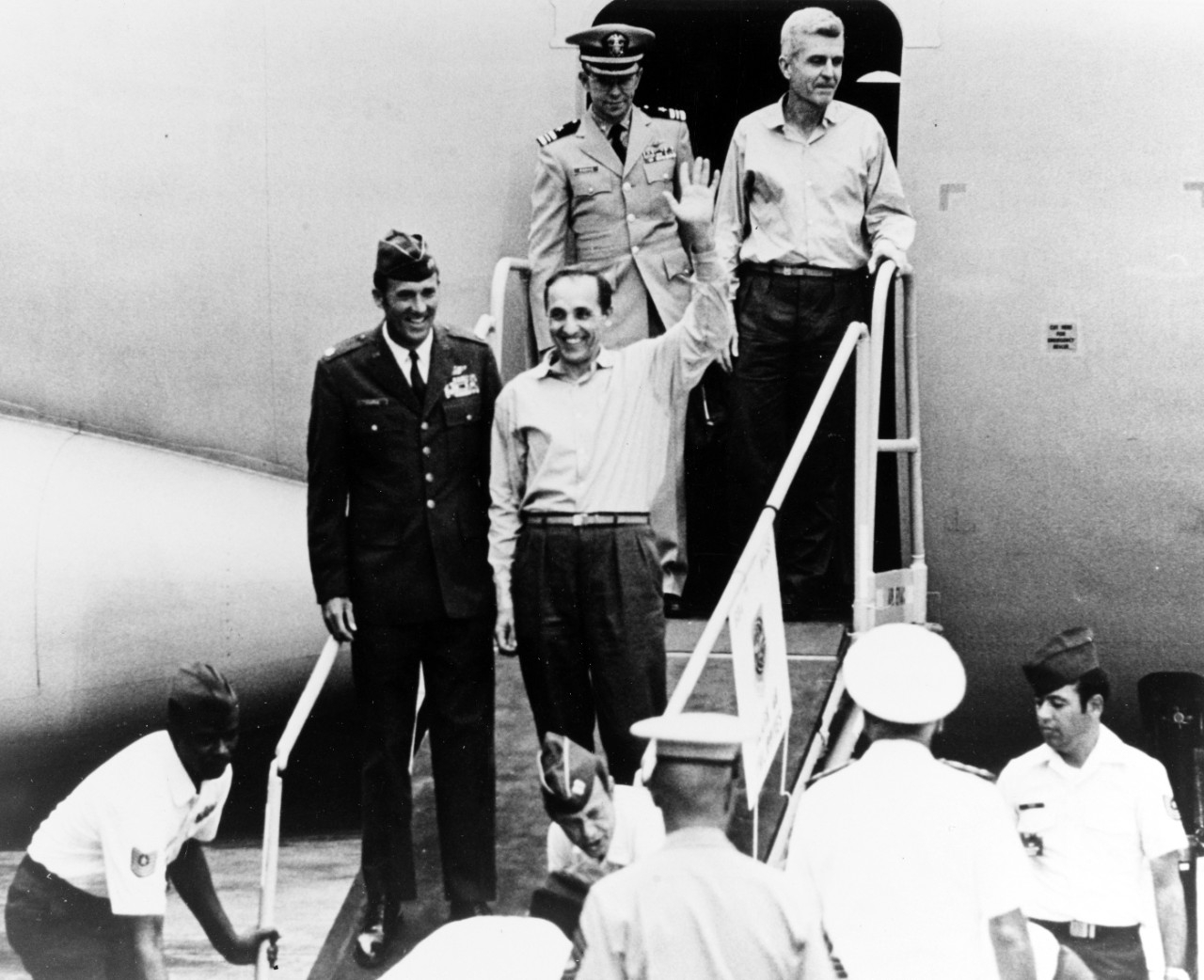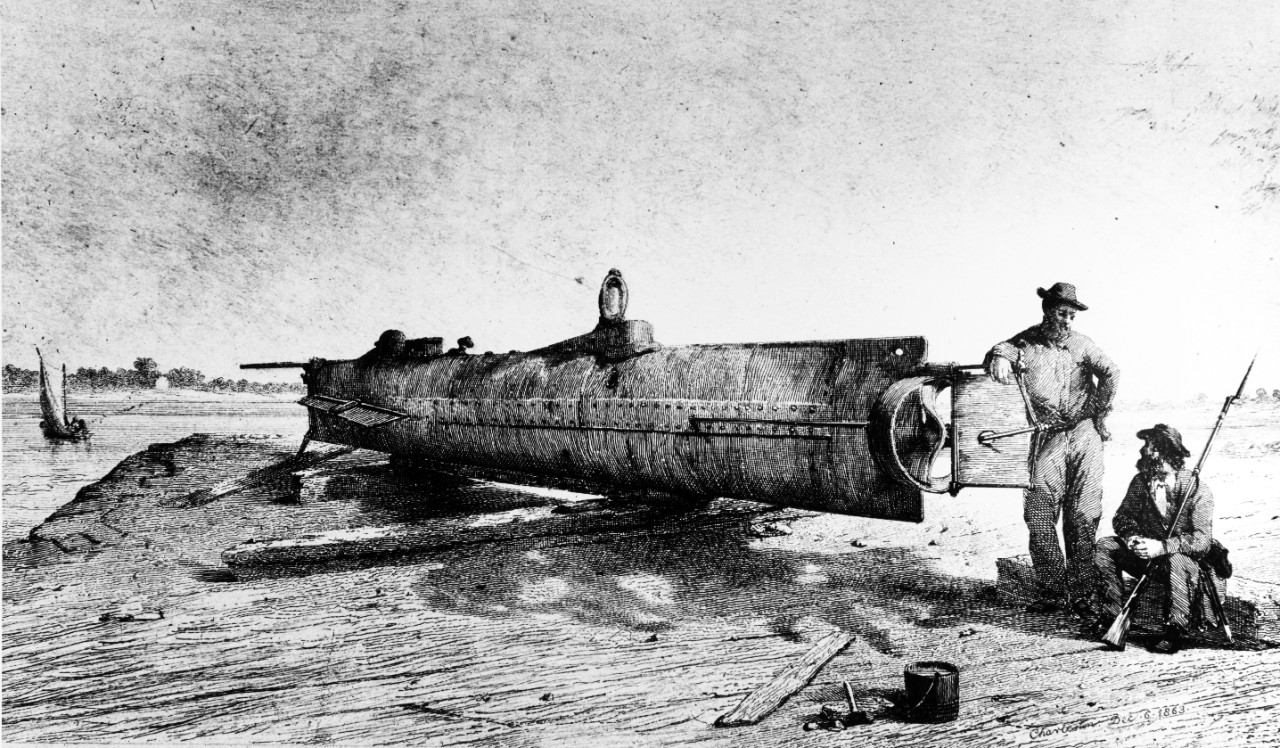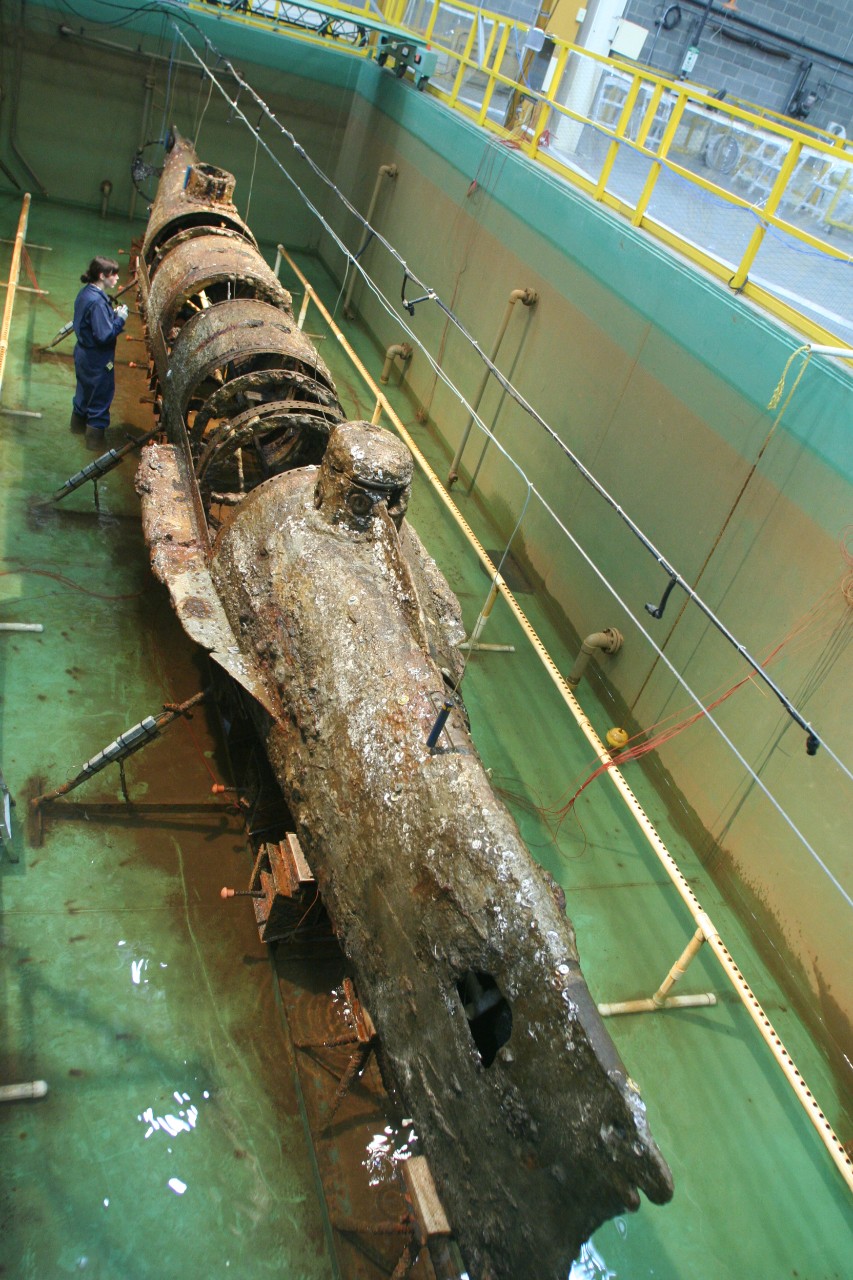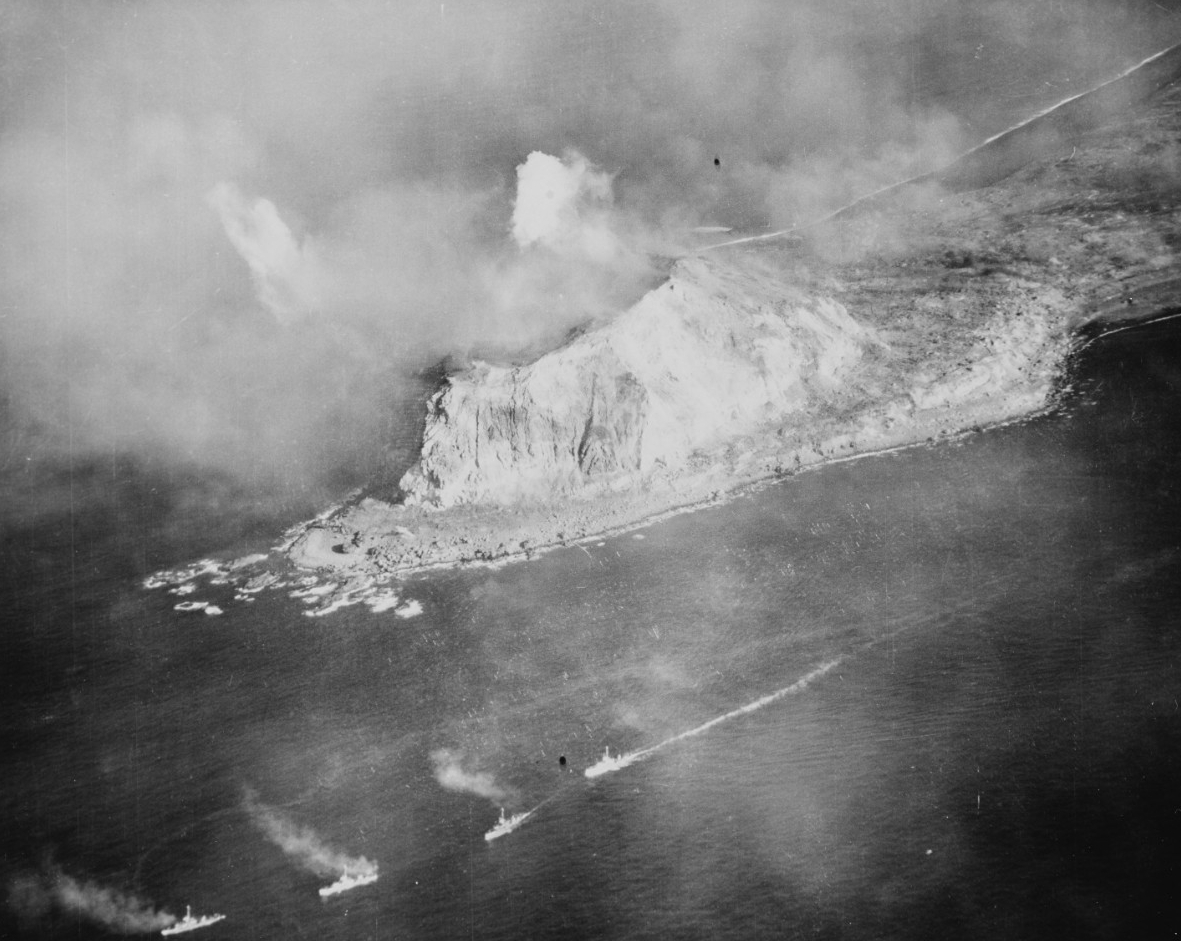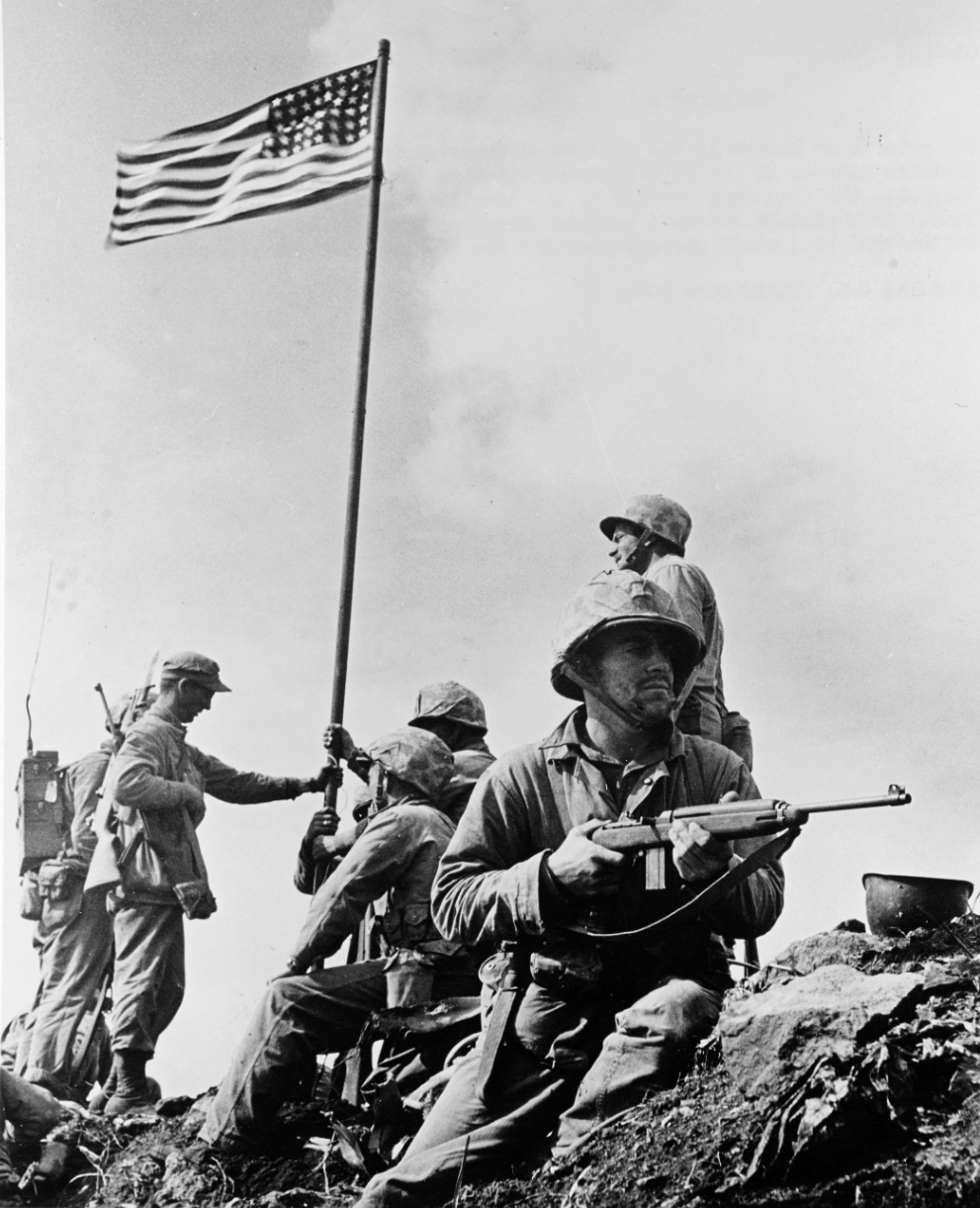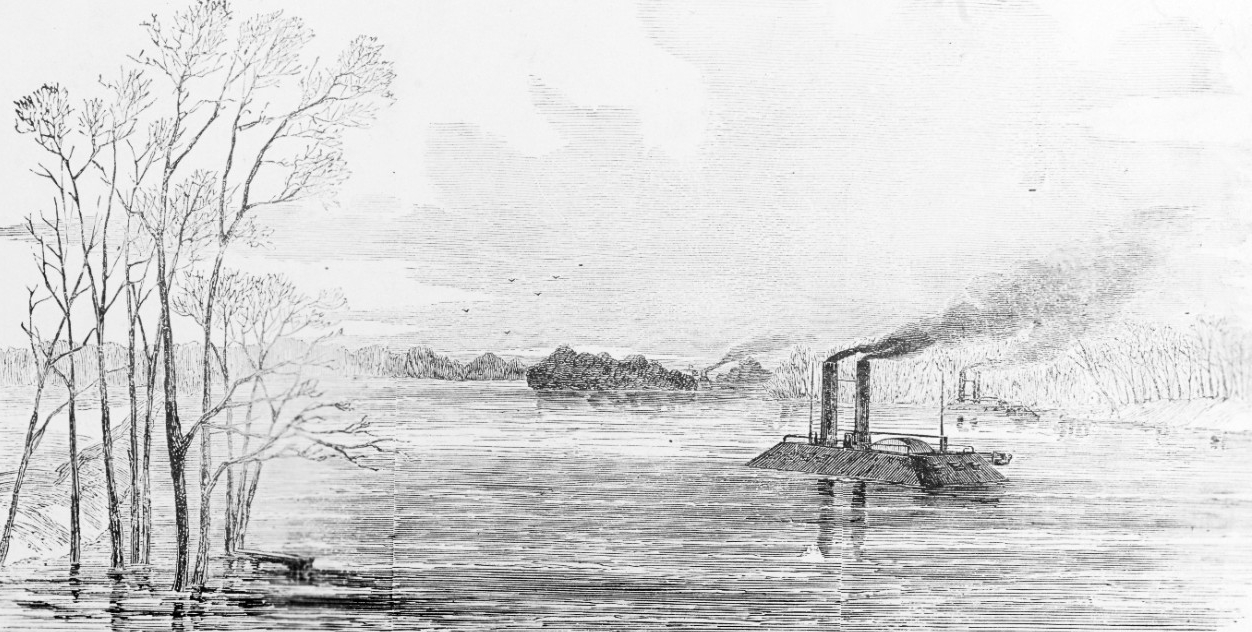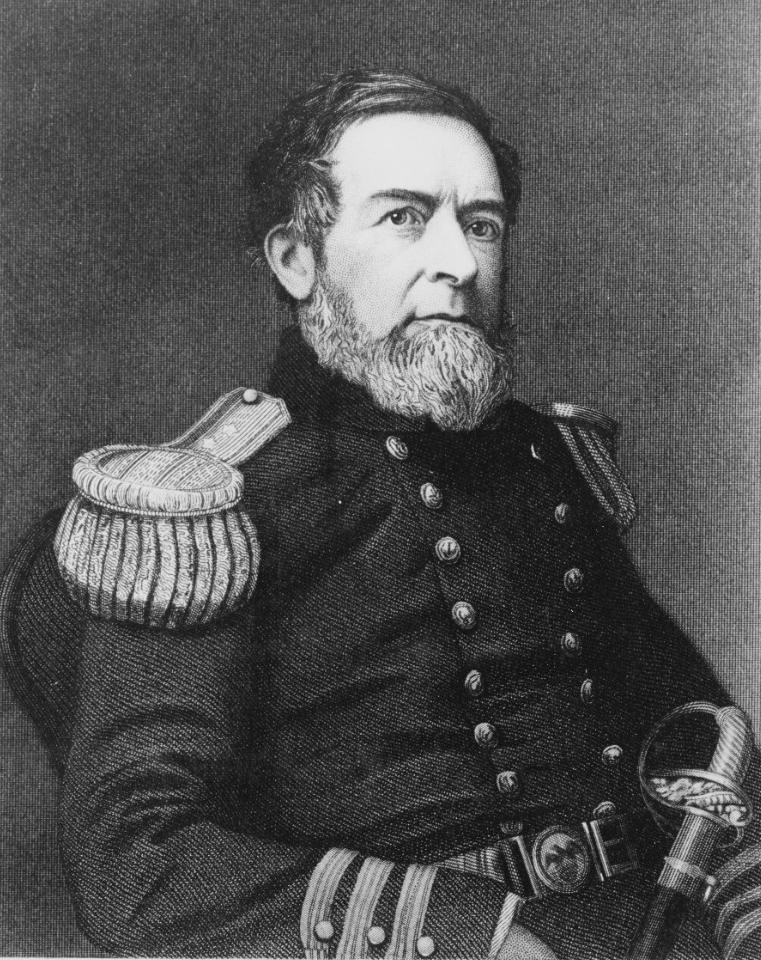Compiled by Brent A. Hunt, Naval History and Heritage Command’s Communication and Outreach Division
Operation End Sweep Begins, Vietnam War Ends
On Feb. 6, 1973, in accordance with the long-sought Paris Peace agreement that brought a cease-fire to the hostilities and formally ended direct American participation in the Vietnam War, Seventh Fleet’s Mine Countermeasures Force (Task Force 78) began Operation End Sweep. The operation’s objective was the clearance of mines along the North Vietnamese coast and inland waterways that had been laid in 1972 as part of Operation Pocket Money. Led by Rear Adm. Brian McCauley, the task force’s minesweepers swept areas off the coast near Haiphong while escorted by guided missile frigate USS Worden (DLG-18) and destroyer USS Epperson (DD-719). Later in the month, amphibious ships joined the task force. These carried CH-53D Sea Stallion helicopters from the Navy’s Helicopter Mine Countermeasures Squadron 12 and Marine Medium and Heavy Helicopter Squadrons HMM-165 and HMH-463.
The American task force began airborne minesweeping in the primary shipping channel to Haiphong on Feb. 27 and in the ports of Hon Gai and Cam Pha on March 17. During the early part of April, MSS-2, an old decommissioned LST (landing ship, tank), filled with foam and other buffers and crewed by a few brave volunteers, made eight check runs up the Haiphong channel to ensure that no mines threatened the vital waterway. Meanwhile, U.S. naval instructors trained North Vietnamese personnel to conduct minesweeping operations on rivers and inland waterways. Furthermore, C-130 transport aircraft flew into Cat Bi Airfield to transfer minesweeping gear to the North Vietnamese. Airborne and surface sweeping operations continued in Haiphong Harbor and northern areas until April 17, when U.S. leaders temporarily withdrew the task force to persuade the North Vietnamese to adhere to the terms of the Paris agreement. On June 18, convinced that Hanoi had received the intended message, Operation End Sweep was restarted, and the task force returned to their anchorage off Haiphong. In a little more than a week, Adm. McCauley declared the water approaches to Haiphong and the harbors of Hon Gai and Cam Pha free of danger from mines. Afterward, the task force worked the coastal areas off Vinh in southern North Vietnam. Finally, on July 18, 1973, Operation End Sweep was completed, and Seventh Fleet departed North Vietnamese territorial waters.
Also under the provisions of the Paris agreement, the North Vietnamese government agreed to release all American prisoners of war within two months in exchange for the U.S. military withdrawal from South Vietnam. During February and March, U.S. aircraft touched down at Gia Lam Airfield in Hanoi to repatriate 138 naval aviators, some of whom had been prisoners in North Vietnam since 1964. Navy personnel (mostly aviators shot down over North Vietnam) accounted for 154 of the 600 Americans taken prisoner during the war. The service members were flown to reception centers in the Pacific and the United States, where they received an emotional welcome home from families and friends. The repatriation program, dubbed Operation Homecoming, ensured that the former POWs received extensive medical, psychological, and emotional support for their transition from captivity to freedom. In the same two months, the Navy closed down all remaining base facilities, offices, and commands in South Vietnam. Advisors, the first naval personnel to deploy to Vietnam in the 1950s, were also the last to leave. On Feb. 11, the Coast Guard disestablished the office of the Senior Coast Guard Officer, Vietnam, and airlifted out all of its personnel from the country. Soon afterward, the fleet air reconnaissance and communications detachments at Danang relocated to Cubi Point in the Philippines. Finally, on March 29, the Naval Advisory Group and Naval Forces, Vietnam, were formally disestablished. Thereafter, only the U.S. embassy’s defense attaché office remained in South Vietnam.
Although the direct role for the United States in the conflict ended in 1973, fighting between North and South Vietnam continued until April 30, 1975, with the Fall of Saigon. In 1976, Vietnam was unified as the Socialist Republic of Vietnam, though sporadic violence continued over the next 15 years, including conflicts with neighboring China and Cambodia. In 1986, when a broad free market policy was put into place, the economy of Vietnam began to steadily improve, boosted by oil export revenues and an influx of foreign capital. Trade and diplomatic relations between Vietnam and the U.S. resumed in the 1990s.
First Warship Sunk by Submarine
On Feb. 17, 1864, under the cover of darkness, Confederate submarine H.L. Hunley silently approached U.S. Navy ship Housatonic, a 16-gun, 1,240-ton sloop-of-war on blockade duty four miles off the entrance to Charleston Harbor, South Carolina. As the submarine advanced, Housatonic’s officer-of-the-deck, Acting Master John Keyes Crosby, sighted an object in the water about 100 yards away, approaching the ship. Although Housatonic’s chain was slipped, the engine backed, and all hands called to quarters, it was too late. Within minutes of the sighting, H. L. Hunley rammed into Housatonic’s starboard side, forward of the mizzenmast and below the waterline, carrying a “torpedo”—as waterborne explosive charges were then known—packed with black powder bolted to a 16-foot spar. As the torpedo detonated, a muffled explosion, reportedly like that of a 12-pound howitzer shell, erupted. Some of Housatonic’s crewmembers also reported pieces of timber hurtling to the top of the mizzenmast while a dark column of smoke rose high in the sky. In the aftermath, as Housatonic began to sink in the shallow waters (about 30 feet in depth), the crew managed to lower two boats that took all the Sailors they could hold. Most of the crew saved themselves by climbing into the rigging that remained above water. Ultimately, five of the ship’s crew were either killed in the explosion or drowned. Sloop-of-war Canandaigua, which was also in the area blockading Charleston Harbor, rescued 150 of Housatonic’s crew. H.L. Hunley earned the distinction as the first submarine to sink an enemy ship in combat. In the aftermath, Union forces blockading Charleston were enraged by the loss of Housatonic. Over the next 24 hours, the average rate of artillery fire into Charleston increased dramatically.
However, H.L. Hunley’s victory was short-lived. After the attack, the submarine failed to return to Battery Marshall, Sullivan’s Island, South Carolina, from its mission to disrupt the blockade. Although the exact cause of H.L. Hunley’s loss is not known, it has been suggested that the submarine may have gone down beneath Housatonic during the explosion or when it was backing away. Another theory suggests it could have been swamped by waves caused by the sinking Housatonic. Later, in 2017, researchers at Duke University speculated that the blast from the torpedo produced a shock wave that ruptured blood vessels in the crew’s lungs. Known as blast lung, it either killed the crew instantaneously or incapacitated them, causing H.L. Hunley to sink.
In 1995, 131 years after the attack, the search for H.L. Hunley ended when best-selling author Clive Cussler and his team from the National Underwater and Marine Agency (NUMA) discovered the submarine after a 14-year search. At the time of the discovery, Cussler and NUMA were conducting research in partnership with the South Carolina Institute of Anthropology and Archaeology (SCIAA). The team realized that they had found H.L. Hunley after exposing the forward hatch and the distinctive ventilator or snorkel box used for refreshing the air inside. The submarine was resting four miles offshore on its starboard side at about a 45-degree angle and was covered in an encrustation of ferrous oxide bonded with sand and shell particles.
Due to concerns that the historic vessel would be disturbed or damaged now that its location was publicly known, the decision was made to raise H.L. Hunley from its resting place. In the summer of 2000, a team of professionals from the Naval History and Heritage Command’s Underwater Archaeology Branch, the National Park Service, and SCIAA excavated the site, measuring and documenting the hull prior to preparing it for removal. Once the on-site investigation was complete, customized slings were slipped underneath the submarine one by one and attached to a truss. The truss was then hoisted from the murky waters by crane from jack-up barge Karlissa-B. On Aug. 8 at 8:37 a.m., H.L. Hunley broke the surface for the first time in more than 136 years. Once safely on its transporting barge, H.L. Hunley finally completed its last voyage back to Charleston, passing by hundreds of spectators on the city’s shores and bridges. The recovery operation came to an end when the submarine was secured inside the Warren Lasch Conservation Center, now part of the Clemson University Restoration Institute, in a specially designed tank of freshwater to await conservation. Conservation efforts continue today with support from Clemson University and Friends of the Hunley. H.L. Hunley can be viewed during tours at the Warren Lasch Conservation Center in Charleston.
Battle of Iwo Jima
On Feb. 19, 1945, following intermittent naval gunfire and aerial bombardment, U.S. Marines from the 4th and 5th Divisions landed on the mountainous volcanic island of Iwo Jima. Originally planned as a brief operation, the Battle of Iwo Jima would go on to be one of the bloodiest battles in U.S. history—lasting five hard-fought weeks that cost the lives of nearly 7,000 U.S. service members. Located just 750 miles from Japan’s coast, Iwo Jima was projected to be a U.S. Army Air Forces base for escort fighters and an emergency landing strip for damaged bombers returning from raids on Japan’s mainland. However, some 21,000 dug-in Japanese troops awaited the American amphibious landing. Once the Marines hit the beaches, enemy artillery and mortar fire severely hampered the initial landing wave. In addition, the unstable terrain composed of steep terraces of constantly shifting black sand, volcanic cinders, and ash complicated matters as well. Tracked vehicles, amphibious tractors, tanks, and supplies were also hindered by the rough terrain, causing pileups at multiple locations. However, the landings were initially successful under the cover of naval gunfire barrage and close air support mainly provided by Fifth Fleet’s escort carriers. The 5th Marine Division pushed to the northwestern shore within 90 minutes to isolate Mount Suribachi, on Iwo Jima’s southern tip, and the 4th Marine Division advanced toward the airfields. By the end of the first day, there were about 30,000 Marines on the shores of Iwo Jima, but casualties were heavy.
The 3rd Marine Division landed on the operation’s second day. Thus, within several days of the initial invasion, some 70,000 Marines had landed on Iwo Jima. The Japanese suffered heavy losses and ran low on supplies as well. They mounted most of their counterattacks under the cover of darkness. Although the Japanese tactics were somewhat effective, the fall of Iwo Jima was inevitable. Just four days into the fighting, U.S. Marines captured Mount Suribachi, famously raising an American flag at the summit. However, the fighting was far from over. Battles raged on in the northern part of the island for weeks. Gen. Tadamichi Kuribayashi, commander of the Japanese forces on Iwo Jima, even set up a garrison in the northern mountains and mounted a final banzai attack on March 25. American forces suffered a number of casualties during the suicide attack, but Iwo Jima was finally declared secure the following day. However, U.S. forces spent weeks trudging through the churned-up terrain finding or killing holdouts who refused to stop fighting or be captured. Dozens of Americans were killed in the process of clearing the island.
In the end, of the 21,000 Japanese troops based on Iwo Jima, only 200 were captured. Many Japanese soldiers resorted to suicide rather than become prisoners of war. In addition, Iwo Jima was never used as an air base to support the bombing campaign against Japan. However, Navy Seabees rebuilt the airfields for pilots to use in case of emergency landings. Adm. Chester W. Nimitz, commander of Pacific Fleet and Pacific Ocean Areas, noted after the battle that “uncommon valor was a common virtue.” Twenty-two U.S. Marines and five Sailors were awarded the Medal of Honor for their heroism on Iwo Jima, 14 of them posthumously.
Today in Naval History—Foote’s Gunboats Capture Fort Henry
On Feb. 6, 1862, during the Civil War, U.S. Navy Capt. Andrew H. Foote’s detachment from the Western Gunboat Flotilla—consisting of seven gunboats, four ironclads, and three “timberclads”—began to attack Fort Henry on the Tennessee River. With ironclads leading the way, Foote’s fleet began firing on the Confederate fort at 1,700 yards and continued unabated until the vessels were within range of the fort’s guns. As the attack continued, Foote’s gunboats wreaked havoc on the fort’s defenses. Brig. Gen. Lloyd Tilghman, commander of Fort Henry, knew he would not be able to hold it for very long and began sending his 2,500 troops to nearby Fort Donelson to prepare a stronger defensive line. He stayed with his artillery in an attempt to distract the gunboats as his soldiers retreated from the rear of the fort. Eventually, Fort Henry’s artillery fell silent when seven of its 11 guns became inoperable. Acknowledging his defeat, Tilghman surrendered the nearly empty fort to Foote.
Before the battle began, U.S. Army Brig. Gen. Ulysses S. Grant’s army and Foote’s naval forces were planning a joint operation to capture Forts Henry and Donelson. However, upon arrival, Foote decided to attack Fort Henry while Grant’s troops were en route to the battlefield. Foote’s small contingent of vessels completed the naval assault almost unscathed—only ironclad steamer Essex was damaged by return fire from the fort. Twenty-nine of its crew, including its commander, Capt. David D. Porter, were among those injured during the brief barrage. After the fall of Fort Henry, Foote’s detachment returned to Cairo, Illinois, located at the convergence of the Mississippi and Ohio Rivers, for repairs. Although the battle for Fort Henry was short-lived, Fort Donelson, just 12 miles to the west on the Cumberland River, now stood alone guarding the Confederacy’s western heartland.
While Foote’s detachment was in Cairo, Grant was determined to rapidly take Fort Donelson. He sent a reconnaissance patrol to evaluate the fort’s defenses and awaited the return of Foote’s naval force. On the morning of Feb. 12, Grant decided to march his 15,000 troops toward Fort Donelson. The Confederates countered and began to move a relatively equal number of troops to meet the Federal force. Although Foote felt that Grant’s movements were unnecessarily urgent, he conceded and quickly transferred men from disabled vessels to his readied ships. After recalling the timberclads from their mission on the Tennessee River, Foote departed Cairo with four ironclad gunboats.
On Feb. 13, Grant’s troops began to probe Confederate lines. Ironclad river gunboat Carondelet was the first of Foote’s vessels to arrive that evening outside the fort on the Cumberland River. The next morning, Foote and Grant discussed their next moves. Foote wanted to wait for mortar boats to compliment his force, but Grant insisted he recreate his success at Fort Henry with his gunboats. Foote conceded again. Unfortunately, the batteries at Fort Donelson were better emplaced and therefore had more effective fields of fire. As the battle commenced, artillery from the fort disabled three of the four gunboats within a few hours. Foote himself was injured during the bombardment while aboard his flagship, St. Louis. As a result, the gunboats were forced to withdraw. On Feb. 15, Grant prepared for the siege of Fort Donelson with his army, and the three Confederate brigadier generals inside the fort planned their defense. The following day, the fort fell to Grant’s army in a brutal, hard-fought battle. Poor coordination among the Confederate commanders was mostly to blame for the South’s defeat (two of the generals present abandoned the post all together). Confederate Gen. Simon B. Buckner asked for an armistice and surrender terms from Grant. Although Buckner tried to use his leverage as an old friend, Grant refused, demanding an unconditional surrender. In the end, Buckner turned over 15,000 troops, 20,000 rifles, 48 pieces of artillery, 17 heavy guns, about 3,000 horses, and large commissary stores.
The battle for Fort Donelson was costly on both sides. The Confederacy had 1,500 to 3,500 killed in action. The Union suffered about 500 dead with an additional 2,100 wounded. Although an estimated 3,000 Confederates managed to escape, the defeat demoralized the South. Citizens in Nashville rioted, and hopes of help from England were diminished. Confederate forces were forced to retreat to the Western Theater. Tennessee was now vulnerable to Union forces.

